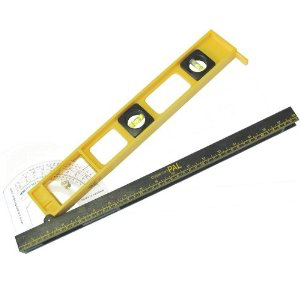
They say necessity is the mother of invention, and eventually, most woodworkers and carpenters need to come up with a better way of dealing with some recurrent problem, annoyance or complexity. Maybe it’s as specific as a one-time shop jig, or as general purpose as a scrap wood sawhorse. For a carpenter in North Carolina, it was the problem of dealing with two intersecting roof angles and figuring the top and bottom angles on a handrail so they ran parallel to the incline of the steps. His solution combined an angle chart with a wood bar hinged onto a level.
When his employer, remodeling contractor Chuck Haley, saw the invention, he realized how useful it would be.
“I told him I would invest in it and help to develop it,.” Chuck recalled. “The more we worked with it & the more useful it became, the more things it would do & the more people would like it. We kept on with it and here we are 2-1/2 years later with a manufactured product.”
The Carpenter’s PAL is manufactured in Greensboro, North Carolina. They’ve gotten the word out by hitting the major hardware shows and teaming up with manufacturers’ reps working in the marketplace. Other distribution channels are in the works. They’ve also shipped product to Puerto Rico and developed a metric version for customers in Canada, the UK, Australia, and New Zealand. In fact the metric version is currently being featured on the UK version of QVC. For now, Chuck thinks the company web site is the best venue for ordering.
“There are a lot of different uses. We used to comment that you could take this tool and a circular saw, hammer, and nails and build an entire deck with it. It makes it very simple to do step stringers and to lay out rafters. We have people calling us with all kinds of uses they have come up with in areas where they had been having difficulty before.”
“There are a lot of different uses. We used to comment that you could take this tool and a circular saw, hammer, and nails and build an entire deck with it. It makes it very simple to do step stringers and to lay out rafters. We have people calling us with all kinds of uses they have come up with in areas where they had been having difficulty before.”
As a new tool on the market, Chuck thinks its real-life, on-the-job genesis gives it an advantage over other inventions.
“We didn’t sit down in the garage one day and say let’s think of something we can make money on. There was a need for it. A builder might tell us he can figure the degree cut he’ll need on the side of a dormer going into the roof line without the Carpenter’s PAL. And we say sure & you can go in there with a square, a level, and straightedge, but wouldn’t you rather send this tool and your $8-an-hour helper up there to do it? And for the DIY market, it takes all the intimidation out of a project the average person might think he couldn’t do.”
Chuck and his crew’s primary business is still remodeling (of course using the Carpenter’s PAL all the time) as he invests, promotes and markets the tool.
“We are getting great success with it, but you have to understand we are unknown in the industry. We are beginning to turn some heads and we have had some major tool manufacturers talk to us. There has been talk of including the Carpenter’s PAL in their packaging, and we are even talking about offering some dual packaging ourselves. We are also in the process of developing other products.”
P is for Pitch & as in the pitch of a roof. The black bar rests on the roof, while the yellow bar (the level) establishes a level position. When the two are locked in place, an outer degree dial establishes the roof’s pitch and rise per 12 inches, while the inner dial provides the degree required to cut horizontal siding or sheeting
A is for Angle … as in the angle of a handrail for existing steps. The black bar is placed over two steps so the yellow bar can determine a vertical plum level position. This establishes the proper cutting angle for the top and bottom rails to run parallel to the incline of the steps.
L is for Level & as in the basic horizontal or vertical level the tool provides when the two bars are locked together.
Plus … Locked to 90 degrees, the Carpenter’s PAL also functions as a framing square. A predetermined angle can be dialed and locked into place. The yellow bar is just a pencil mark shy of 16″ so it’s perfect for laying out a framing wall. And the black bar has a compartment for storing pencils.





